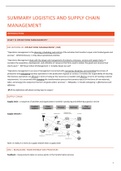SUMMARY LOGISTICS AND SUPPLY CHAIN
MANAGEMENT
INTRODUCTION
WHAT IS OPERATIONS MANAGEMENT?
DEFINITIONS OF OPERATIONS MANAGEMENT (OM)
“Operations management is the planning, scheduling, and control of the activities that transform inputs into finished goods and
services” - APICS Dictionary => Only about operational activities
“Operations Management deals with the design and management of products, processes, services and supply chains. It
considers the acquisition, development, and utilization of resources that firms need to deliver the goods and services their
clients want.” - MIT Sloan School of Management => Includes design ass well
“Operations management is an area of management concerned with overseeing, designing, and controlling the process of
production and redesigning business operations in the production of goods or services. It involves the responsibility of ensuring
that business operations are efficient in terms of using as few resources as needed, and effective in terms of meeting customer
requirements. It is concerned with managing the transformation process that converts inputs (in the forms of raw materials,
labor, and energy) into outputs (in the form of goods and/or services).” – Wikipedia => Include redesigning + effectiveness and
efficiency
è All the definitions talk about turning input in output!
SUPPLY CHAIN
Supply chain = a sequence of activities and organizations involved in producing and delivering a good or service
Supply network =
Note: in reality it is more of a supply network than a supply chain
OM = MANAGING TRANSFORMATION PROCESSES
Feedback = measurements taken at various points in the transformation process
1
,Control = the comparison of feedback against previously
established standards to determine if corrective action is needed
Two types of inputs:
o Inputs that need to be transformed
o Inputs that are used to transform other inputs e.g.
employees
3 types of typical transformation processes:
I. Typical material processors e.g. mining and extraction, food production, automotive, assembly, machine construction, retail
operations, warehousing and distribution, postal services, transport
II. Typical information processors e.g. accountants, bank back offices, market research organization, financial analytics, news
service, university research unit, archives, telecom company
III. Typical people processors e.g. hairdressers, hotels, hospitals, mass rapid transports, theaters theme parks, dentist, schools
PRODUCTION OF GOODS VS DELIVERY OF SERVICES
Goods = physical items that include raw materials, parts, subassemblies, and final products
Services = activities that provide some combination of time, location, form, or psychological value
è Often occur jointly e.g. having the oil changed in your car is a service, but the oil that is delivered is a good
Characteristic Goods Services
Output Tangible Intangible
Customer contact Low High
Labor content Low High
Uniformity of input High Low
Measurement of productivity Easy Difficult
Opportunity to correct problems before delivery High Low
Inventory Much Little
Wages Narrow range Wide range
Patentable Usually Not usually
The goods-service continuum:
MANUFACTURING MATTERS!
Trends
o Shift from the manufacturing sector to the service sector
o Development towards a knowledge economy
o Many services exist to support manufacturing => Many jobs/companies would disappear if we didn’t have
manufacturing
2
, o Manufacturing and innovation
• Manufacturing naturally leads to innovation
• Return on innovations: after R&D
DECISION HORIZON
3 types of issues (/decisions):
o Strategic issues e.g. determining the size and location of manufacturing plants, deciding the structure of services or
telecommunications networks, and designing technology supply chains => Long-term decisions, taken by top-management
o Tactical issues e.g. plant layout and structure, project management methods, and equipment selection and replacement => Only
made by managerial levels, mid-term decisions
o Operational issues e.g. production scheduling and control, inventory management, quality control and inspection, traffic and
materials handling, and equipment maintenance policies => Make and change on daily bases
WHY LEARN ABOUT OPERATIONS MANAGEMENT?
STRATEGY AND COMPETITION
Business strategy: sets terms and goals for a company to follow = long term plan of action
o Marketing strategy e.g. how will you generate sales
o Operations strategy = the means by which the firm deploys its resources to achieve its competitive goals e.g. producing
the cheapest in your business, or be very responsive
o Financial strategy e.g. where will you get the money to do your business + how organize financial matters
Samples operations strategies:
Organizational strategy Operations strategy Examples of companies or services
Low price Low cost U.S. first class postage
Wal-Mart
Responsiveness Short processing times McDonald’s restaurants
On-time delivery FedEx
3
, Differentiation: high quality High performance design and/or high- Sony TV
quality processing
Consistent quality Coca-Cola
Differentiation: newness Innovation 3M, Apple
Differentiation: variety Flexibility Burger King (‘Have it your way’)
Volume McDonald’s (‘Buses Welcome’)
Differentiation: service Superior customer service Disneyland
IBM
Differentiation: location Convenience Supermarkets; Mall stores
A FRAMEWORK FOR OPERATIONS STRATEGY
Strategy dimensions:
o Cost
o Product differentiation (both differentiation from competitors and differentiation within a firm)
o Quality
o Delivery speed
o Delivery reliability
o Flexibility
Operations management is concerned with implementing the operations strategy to achieve along one or some of these
dimensions (you can’t be the best in every dimension)
Competitiveness:
o How effectively an organization meets the wants and needs of customers relative to others that offer similar goods or
services
o Organizations compete through some combination of their marketing and operations functions
• What do customers want?
• How can these customer needs best be satisfied?
STRATEGY FORMULATION
Effective strategy formulation taking into account:
o Core competencies
o Environmental scanning
à SWOT
• Internal factors => strengths and weaknesses
• External factors => opportunities and threats
Successful strategy formulation also requires taking into account:
o Order qualifiers = characteristics that customers perceive as minimum standards of acceptability for a product or
service to be considered as a potential for purchase
o Order winners = characteristics of an organization’s goods or services that cause it to be perceived as better than the
competition => Not what is necessary, but what you offer on top
SUSTAINABILITY AS AN OPERATIONS STRATEGY
Some people still think of sustainability as a cost center, but do not realize that this can offer many benefits e.g. Nike, Delhaize
4




